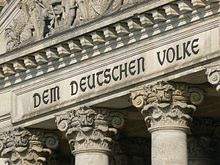Loevy
Loevy is the name of a Berlin entrepreneurial family and their art foundry, which operated as S. A. Loevy .
family
- Samuel Abraham Loevy (1826–1900)
He came to Berlin from the Prussian province of Posen in the mid-19th century and founded the company. - Albert Loevy (1856–1925), son of Samuel Loevy
1883 master brass caster
In the 20th century, focus on commercial management. - Siegfried Loevy (1859–1936), son of Samuel Loevy
father of Erich Gloeden
In the 20th century, focus on artistic direction.
Buried in St. Elisabeth Cemetery I in Berlin-Mitte. - Erich Loevy (1888–1944), since 1918 Erich Gloeden , architect
Family members were murdered in concentration camps .
Companies
On April 1, 1855, Samuel Loevy founded the "Roth and Yellow Foundry" at Große Hamburger Straße 8 in Berlin-Mitte . He soon specialized in art foundry for bronze . In 1865 the company moved within Berlin-Mitte to the Scheunenviertel , where many Jewish craftsmen were based. In 1898 the company moved to Gartenstrasse 158 (today No. 96) in Berlin-Mitte.
From 1885 Albert and Siegfried continued to run the company as the Loevy brothers .
After the National Socialists came to power , the Jewish company ran into trouble. In 1934 the company premises in Gartenstrasse had to be sold to the Deutsche Reichsbahn . The company moved to Neuenburger Strasse 29 in Kreuzberg . In 1939 operations finally had to be stopped.
Products
Over the decades, the foundry produced countless individual pieces as well as small series of sculptures. The largest sculpture was a six-meter-high Dioscuri couple by Eberhard Encke .
They attracted attention with fittings (for doors and furniture) from the Art Nouveau and Art Deco periods . Many well-known designers and architects of the period designed for the bronze goods factory: Henry van de Velde , Peter Behrens , Bruno Paul , Heinrich Straumer , Walter Gropius , Ludwig Mies van der Rohe , Erich Mendelsohn , Wilhelm Wagenfeld . Walter Gropius designed the so-called Gropius door handle for Loevy in particular .
The German people
In 1916, the inscription DEM DEUTSCHEN VOLKE on the Reichstag building was cast from two French cannon barrels captured from the Wars of Liberation , based on a design by Peter Behrens .
Appreciations
- 1896 “Prussian State Medal for Commercial Achievements” at the Berlin Commercial Exhibition
- 1910 Royal Prussian purveyor to the court for the bronze work on the last new Wilhelmine palace in Posen
- 1999 film “The Loevys - A Family History”, Armin D. Steuer
- 2001 Memorial plaque for the Loevy family in the west entrance of the Reichstag building
- 2003 Exhibition in the Jewish Museum Berlin
literature
- Helmuth F. Braun, Michael Dorrmann: "The German People". The story of the Berlin bronze caster Loevy . Dumont, 2003, ISBN 3-8321-7838-4 (on the exhibition in the Jewish Museum Berlin).
- Bernd Oertwig : The accomplishers of the Reichstag . In: The Parliament , No. 6/7, February 4, 2013.
Web links
- Armin D. Steuer: Reichstag: Letters for the Fatherland. In: one day , October 11, 2007.
Individual evidence
- ↑ Helmuth F. Braun, Michael Dorrmann: "Dem Deutschen Volke". The story of the Berlin bronze caster Loevy. P. 79
- ↑ Gropius-Drücker ( Memento of the original from September 3, 2009 in the Internet Archive ) Info: The archive link was inserted automatically and has not yet been checked. Please check the original and archive link according to the instructions and then remove this notice.
- ↑ Armin D. Steuer - loevy.de
- ↑ Unveiling of the memorial plaque by the President of the Bundestag at bundestag.de
- ^ Exhibition in the Jewish Museum Berlin
